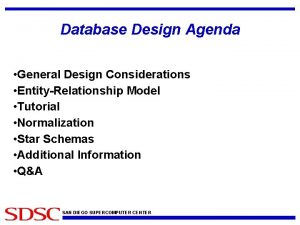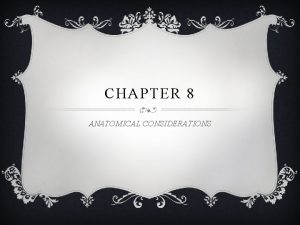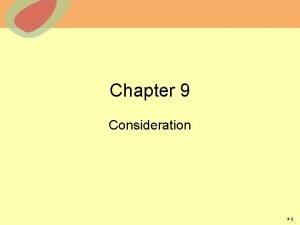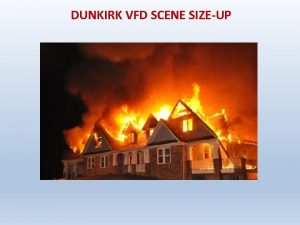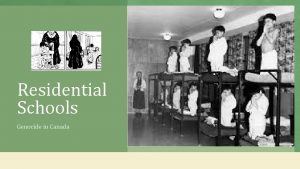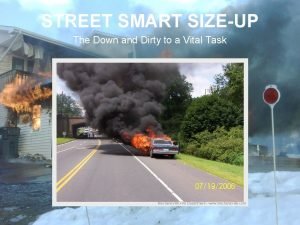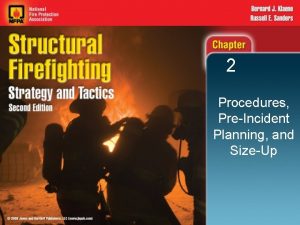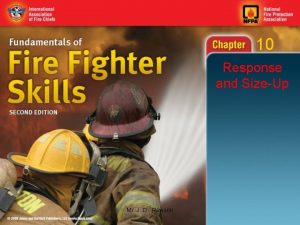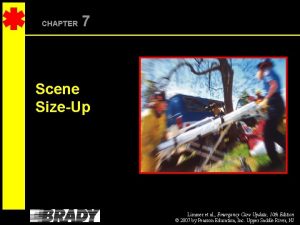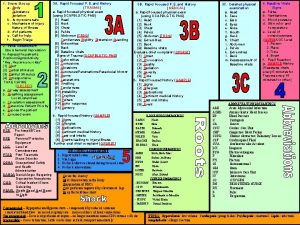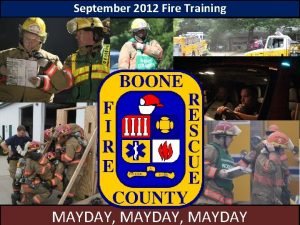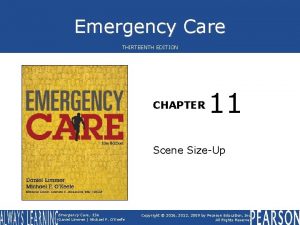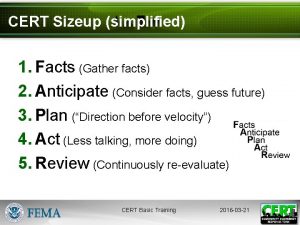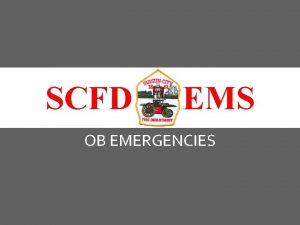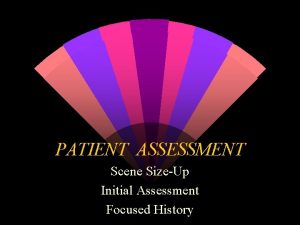SIZEUP REVIEW AND UNIQUE RESIDENTIAL STRUCTURE CONSIDERATIONS Instructor

































- Slides: 33

SIZE-UP: REVIEW AND UNIQUE RESIDENTIAL STRUCTURE CONSIDERATIONS Instructor Danny Braitsch Maryland Fire and Rescue Institute

Objectives ■ Review the concept of size-up of an incident scene. ■ Discuss the importance of conducting a complete and comprehensive size up on an incident scene. ■ Discuss commonly used methods and acronyms/mnemonics that assist in sizing up an incident in a concise but thorough manner. ■ Examine unique and atypical residential structure conditions and considerations. ■ Complete scene size-up scenario drills with crews and coworkers to facilitate conversation about more complex residential structure findings and possibilities.

Size-Up: Review

Size-Up ■ Size-up – The process of gathering and relaying information to assist officers and firefighters in making safe, efficient, and effective decisions on an incident. – – Prepares arriving units for what to expect and how to proceed Answers the following questions: ■ What do I have? ■ What am I doing? ■ What do I need?

Size-Up ■ Initial size up – – Brief Initial Report (B. I. R. ) Conduct a thorough 360º size up ■ Size-up is ongoing – – Prepare for conditions to change at any time C. A. N. status report: Conditions, Actions, Needs

Brief Initial Report (B. I. R. ) ■ Verbal report completed by the first arriving unit ■ Provides insight into the details of the incident for other arriving units ■ Typically follows a format – – – Includes only pertinent information Directs incoming units Establishment of command presence

Brief Initial Report Structure Fire Confirm incident address. Describe the structure: § § Number of floors Type of occupancy (Single-/Multi-family, TH, Comercial, etc) Describe the conditions/pertinent information § § Fire/Smoke Rescue/Life hazard

Brief Initial Report Structure Fire (Cont. ) Advise on water supply/lay out Advise on exposures (if relevant) Announce mode of attack Establish __(Road/Business Name)__ command

C. A. N. Report ■ A C. A. N. Report is a verbalized report made by officers/firefighters on scene to advise on what is happening, what crews are doing, and what else is needed to mitigate the incident ■ Conditions – – – Changes in fire progression, findings of fire in other areas, verbalizing fire out Changing smoke conditions inside/outside of the structure Additional hazards: holes in floors, high heat conditions, etc. ■ Actions – – Water on fire Check for extension ■ Needs – May include equipment, manpower, ventilation, medical, etc.

Basic Size-Up Considerations Arriving on an incident can be overwhelming, particularly for new officers or for uniquely complicated scenes/structures or events Use of mnemonics may prove helpful in remembering what to consider and address while sizing up the structure and making ongoing observations “B E L O W” “C O A L W A S W E A L T H” Building Construction, dimensions, area, age, stories Construction Weather Occupancy Exposures Extent Fire/smoke conditions/spread Area Apparatus/Personnel Life Hazards fire Location/extent of Life Hazards Time of day, cars in driveway, evacuated Time of day Occupancy Residential, commercial, church, mall, etc. Water supply conditions Water supply Hydrant, drafting, need for tankers, etc. Auxiliary systems Street conditions Hazardous

Unique Considerations ■ While utilizing acronyms and mnemonics may be helpful in aiding a concise size -up for more structurally routine and basic residential structures, some homes present unique and atypical conditions. ■ While it is important to be well-versed and practiced on the basics, it is imperative to maintain an open-mind and train to be prepared for any situation or emergency. ■ The following slides will briefly discuss some unique and atypical presentations of single-family residential structures for discussion and review.

Unique Residential Structure Considerations

Unique Considerations Residential Structure Area (Sq. Ft. ) ■ Large homes (with square footage in excess of several thousand sqft) pose unique concerns for firefighters – – – Must consider length of handlines used Firefighters working inside may become lost, confused, or disoriented more easily Extent of fire may be significant inside without any obvious outward signs from the initial size-up and 360º

Unique Considerations Residential Structure Layout/Floor Plan ■ Uniquely-shaped homes – – – Homes shaped in anything other than a typical four-sided A-B-C-D box configuration create issues in clearly explaining location of conditions Create unique and unexpected floor plans May disorient firefighters working inside, making it difficult in an emergency situation to explain where in the building the firefighter is ■ Older homes – – Unexpected/atypical floor plans May have additions/attached structures ■ Open floor plans – Allow for ease of fire spread ■ Unexpected grade changes – Some homes may have access to two or more levels one just one “side” of the structure (e. g. Size-up Practice Scenario 1)

Unique Considerations Residential Structure Content ■ Additions – Owner-built attached rooms/additions and partition walls added to separate rooms may make navigating the home disorienting ■ Conditions of the home – Apparently vacant homes ■ Structural integrity concerns (e. g. holes in floors/walls, compromised structural components) – Hoarding conditions ■ ■ Heavy fire load Increased possibility of collapse, entanglement, becoming confused/disoriented

Unique Considerations Residential Structure Construction ■ Older homes – Balloon-frame construction makes an impact on fire spread – Masonry exterior may present collapse concerns ■ Attachments/additions to home – Additions or attachments to the home made by the owner may not follow fire code and may limit or alter points of egress from the structure (e. g. hiding windows with walls, etc. )

What other unique residential structure features have you come across in your experience as a firefighter?

Size-Up Practice Scenarios

Size-Up Practice Scenarios ■ The following practice scenarios were created to challenge the way you think about sizing up residential structures. Not all residences you encounter will be typical or standard. ■ Three scenarios follow with three slides each – Slide 1: Dispatch information, pictures of structure ■ Practice completing a B. I. R. and 360º size-up. – Slide 2: Discussion questions – Slide 3: Floor plan/pictures of structure for clarity (websites provided)

Size-Up Practice Scenario 1

Size-Up Practice Scenario Slide 1 1 Month: October Time of Day: 12: 35 Weather: Partly cloudy, 55º Front View Box Alarm: Report of smoke in the basement Address: 4321 Mansion Ln Caller is homeowner, states she is the only one home, husband at work and kids are at school, she is vacating the residence CAD notes: Hydrant approx. 400 ft away at cross street Mansion Ln/Harbor Rd Mansion Ln is a no-outlet residential street Rear View

Size-Up Practice Scenario Slide 2 1 Before viewing floor plans, where you consider making access to investigate a report of smoke in the basement? Which side of the building is Alpha side? Bravo? Charlie? Delta? Would you express this any differently on a fireground to ensure clarity? Consider grade changes to the rear of the building. The backside of this building has entry points at both ground and basement level. Consider size of building (over 4, 000 sq. ft. ) and its unique floor plan How would this impact choice of handline? How would this impact search operations? What are your search/rescue considerations? What other considerations might you make with regard to Time of day? Weather conditions? Water supply? Think: C. O. A. L. W. A. S. W. E. A. L. T. H and B. E. L. O. W.

Floor Plans Size-Up Practice Scenario Slide 3 1 Main Floor Basement Obtain more detailed images of this structure at: https: //architecturalhouseplans. com/product/unique-european-style-luxury-home/

Size-Up Practice Scenario 2

Size-Up Practice Scenario Slide 1 2 Front View Month: January Time of Day: 17: 35 Weather: Cold 41º, Windy 13 mph Box Alarm: Report of fire in the home Address: 1234 Crystal View Dr Caller is homeowner, noticed smoke and fire coming from second floor storage room CAD notes: Not a hydranted area, nearest cistern approx. 2. 5 miles away Crystal View is a no-outlet residential street Rear View

Size-Up Practice Scenario Slide 2 2 Before viewing floor plans, where would you expect to find the storage room of this structure, assuming you see no fire upon arrival. Where would you believe the stairs to be? Which side of the building is Alpha side? Bravo? Charlie? Delta? Would you express this any differently on a fireground to ensure clarity? Consider size of building (approx. 1, 600 sq. ft. ) and its unique floor plan. How would this impact choice of handline? How would this impact search operations? What are your search/rescue considerations? What other considerations might you make with regard to Time of day? Weather conditions? Water supply? Think: C. O. A. L. W. A. S. W. E. A. L. T. H and B. E. L. O. W.

Floor Plans Size-Up Practice Scenario Slide 3 2 Main Floor Second Floor Obtain more detailed images of this structure at: https: //architecturalhouseplans. com/product/solar-scoop/ Interior

Size-Up Practice Scenario 3

Size-Up Practice Scenario Slide 1 3 Month: July Time of Day: 20: 45 Weather: Warm, 41º, Nighttime and cloudless Box Alarm: Structure fire Address: 7890 Farmhouse St Caller is a passerby, stated he saw flames inside a window in the structure, had his window down and smelled smoke, caller could not stop CAD notes: Building is believed to be vacant Nearest hydrant approx. 100 ft. from driveway, driveway approx. 800 ft. back and gravel. Front View

Size-Up Practice Scenario Slide 2 3 Before viewing floor plans, how would you believe this building to be laid out? Where would the stairs be? Is there a basement? Which side of the building is Alpha side? Bravo? Charlie? Delta? Consider the size and age (built in 1860) of this building and its distance from the road. How would this impact water supply decisions? Handline choice? How would the construction/age of this structure (balloon frame) impact fire spread? What are your search/rescue considerations? Do you believe this building is unoccupied? What other considerations might you make with regard to Time of day? Weather conditions? Water supply? Think: C. O. A. L. W. A. S. W. E. A. L. T. H and B. E. L. O. W.

Size-Up Practice Scenario Slide 3 3 Floor Plans Main Floor Obtain more detailed images of this structure at: https: //ir. uiowa. edu/cgi/viewcontent. cgi? article=9743&context=annals-of-iowa Second Floor

Conclusion ■ Reviewed the concept of size-up of an incident scene. ■ Discussed the importance of conducting a complete and comprehensive size up on an incident scene. ■ Discussed commonly used methods and acronyms/mnemonics that assist in sizing up an incident in a concise but thorough manner. ■ Examined unique and atypical residential structure conditions and considerations. ■ Provided scene size-up scenario drills to complete with crews and coworkers to facilitate conversation about more complex residential structure findings and possibilities.

References Peterson, F. W. (1993) Tradition and change in the nineteenth-century iowa farmhouses. State Historical Society of Iowa, Vol. 52, Num. 3, pg. 251 -281. Retrieved from: https: //ir. uiowa. edu/cgi/viewcontent. cgi? article=9743&context=annals-of-iowa. Robertson, H. (2010). Drills for practicing how to describe fireground conditions. Fire Rescue Magazine, Vol. 5, Iss. 10. Retrieved from: https: //www. firerescuemagazine. com/articles/print/volume-5/issue-10/training-0/drills-forpracticing-how-to-describe-fireground-conditions. html Rubin, D. L. (1996). Initial operations. Firehouse. com. Retrieved from: https: //www. firehouse. com/home/article/10545545/initial-operations Pictures/floor plans credited to and obtained from the following websites: Architectural House Plans https: //architecturalhouseplans. com/product-category/unusual-houseplans/page/2/? posts_per_page=20 State Historical Society of Iowa: https: //ir. uiowa. edu/cgi/viewcontent. cgi? article=9743&context=annals-of-iowa
 Opqrst-aspn
Opqrst-aspn Unique features of book review
Unique features of book review Writing strategies and ethical considerations
Writing strategies and ethical considerations Ethical considerations in experimental research
Ethical considerations in experimental research Pricing considerations and approaches
Pricing considerations and approaches Unique structure
Unique structure Instructor responsibilities and professionalism lesson plan
Instructor responsibilities and professionalism lesson plan Virtual instructor.com
Virtual instructor.com General consideration in machine design
General consideration in machine design Tax considerations for setting up a new business
Tax considerations for setting up a new business Atm kiosk software
Atm kiosk software Exchange transaction and relationship in marketing
Exchange transaction and relationship in marketing Mechanical considerations of transmission line
Mechanical considerations of transmission line Database design considerations
Database design considerations Contrasting acquisition
Contrasting acquisition Cloud delivery models
Cloud delivery models Chapter 9 pre examination/preanalytical considerations
Chapter 9 pre examination/preanalytical considerations Bioreactor considerations for animal cell culture
Bioreactor considerations for animal cell culture Collaboration design considerations
Collaboration design considerations Biological consideration in fixed prosthodontics
Biological consideration in fixed prosthodontics Antecubial region
Antecubial region Biopharmaceutic considerations in drug product design
Biopharmaceutic considerations in drug product design Mandibular impression landmarks
Mandibular impression landmarks Tactical foul
Tactical foul Myharper blackboard
Myharper blackboard Temperature regulation pdhpe
Temperature regulation pdhpe Gastrectomy anesthesia considerations
Gastrectomy anesthesia considerations Emv kiosk considerations
Emv kiosk considerations Design considerations for mobile computing
Design considerations for mobile computing What is research design in qualitative research
What is research design in qualitative research Fraction of inspired oxygen
Fraction of inspired oxygen Ethical considerations examples
Ethical considerations examples Examples of consideration
Examples of consideration Web security considerations
Web security considerations













